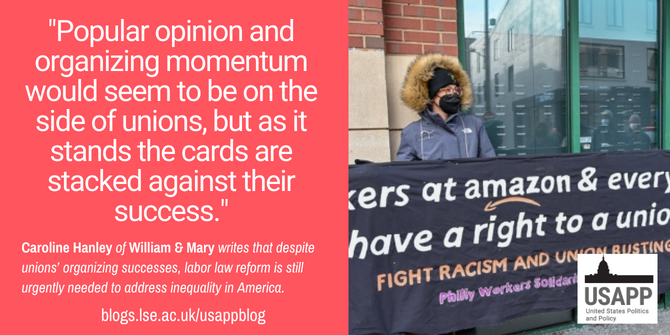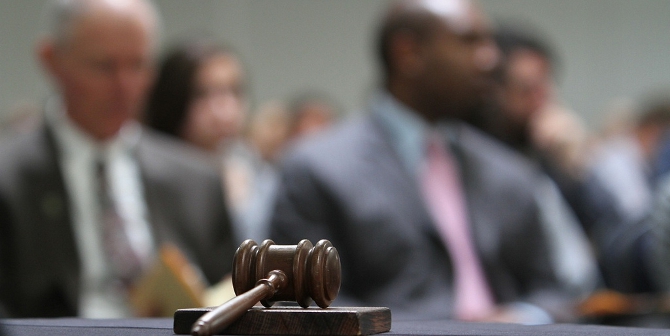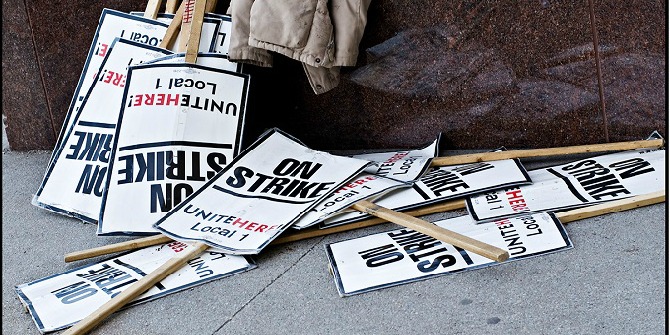 The past year has seen growing unionization efforts by employees of high-profile US organizations like Amazon and Starbucks. Caroline Hanley argues that these unions’ recent organizing successes will improve the lives of American workers, but labor law reform is urgently needed to support the wider union movement and address the American inequality problem.
The past year has seen growing unionization efforts by employees of high-profile US organizations like Amazon and Starbucks. Caroline Hanley argues that these unions’ recent organizing successes will improve the lives of American workers, but labor law reform is urgently needed to support the wider union movement and address the American inequality problem.
After decades of falling membership, labor unions are making a comeback in the American public’s consciousness. The cover of the July 18 issue of New York Magazine featured Chris Smalls, president of the recently formed Amazon Labor Union. Since last year, organizers like Smalls have led efforts by employees of major US corporations such as Amazon and Starbucks to form unions to campaign for better pay and working conditions. But what’s driving this resurgence in labor organizing? At the risk of stating the obvious, the United States has an inequality problem.
Recent debate about whether wage growth is driving inflation notwithstanding (it’s not), real earnings have been stagnant for most American workers for the past forty years despite aggregate gains in productivity, profitability, and economic growth. The distribution of income and wealth is more unequal today than it has been since the Great Depression. While college-educated workers fare better than their counterparts in this highly polarized labor market, higher education is no longer an effective insurance policy against economic insecurity, and its benefits are unequally distributed across racial, ethnic, and gender lines.
Low wages and unpredictable work schedules bring persistent insecurity and hardship to millions, but the effects of historically high levels of inequality extend beyond a society’s most economically vulnerable members. Too much inequality undermines the social fabric, reduces economic growth, limits opportunity, and challenges the viability of democratic institutions. Whether motivated by economic justice, human wellbeing, or economic and political stability, there are good reasons to care about the American inequality problem.
How did we get here?
There is nothing inevitable about the historically high levels of economic inequality that we currently see in the United States. Globalization and new workplace technologies have been associated with rising earnings inequality in the US, but other nations weathered similar competitive and technological changes following the economic crises of the 1970s without the same trajectory of steep inequality growth. Public policy choices—including measures to undermine union organizing and power at the bargaining table, a low-road approach to capitalism with roots in slavery, and systemic racism and sexism in employment law—are responsible for the status quo.
Is inequality simply the price we must pay for economic growth? No, there is no necessary trade-off between economic growth and greater equality. Labor market and welfare state policy can be used to maximize employment while also reducing poverty and maintaining growth, with measures that that make work pay, support workers during periods of unemployment or retraining, offer a minimum basic income for those unable to work, and share the costs of health and childcare.
Unions have an important role to play in advancing this inequality-reducing agenda. When workers successfully exercise their rights to organize and bargain collectively, they create structures for more equitable pay and humane scheduling practices, greater accountability for workplace health and safety violations, and mechanisms for resolving workplace conflicts that can undermine productivity.
Union revitalization?
Many observers have responded to recent high profile organizing victories at large companies like Amazon and Starbucks with a sense of optimism that perhaps the tide is turning in favor of American workers. If that is the case, it is largely down to the hard work of organizing employees themselves. Workers across a range of sectors have embraced collective action in response to poor working conditions. Organizers at Amazon’s warehouses have successfully combined grassroots tactics with persuasive messaging, juxtaposing the extreme profitability of the company with the physical and mental strain caused by unsafe and inhumane working conditions. Members of Starbucks Workers United have cultivated networks across locations to share resources and advance organizing campaigns in over 300 shops, despite the company deploying classic union busting tactics like raising pay at non-union locations, firing workers for organizing, and closing unionized shops.
Popular opinion and organizing momentum would seem to be on the side of unions, but as it stands the cards are stacked against their success. Commentators have noted that, at 68 percent, popular support for unions is at its highest level since 1965. A recent survey found that 59 percent of workers would support a stronger union at their companies. Yet public support for unions has been fairly steady (and consistently above 50 percent) since World War II, even as union membership has declined from about one third of workers in the 1950s to 20.3 percent in 1983 and only 10.3 percent in 2021. Union organizing success does not rest on public opinion. As for momentum, union representation petitions filed with the National Labor Relations Board (NLRB) between October 2021 and March 2022 increased 57 percent compared with the same period a year ago, but the number of annual elections held has been trending down in recent years, from 1,574 representation elections in 2015 to 954 in 2021. It is too soon to say whether organizing momentum will continue through the second half of 2022 and beyond. And organizing a labor union is only the first of many steps toward establishing a functioning collective bargaining relationship that can deliver on the promise of improved working conditions. Union revitalization continues to be an uphill battle.

“Workers at Amazon & everywhere have a ri” (CC BY-NC-SA 2.0) by joepiette2
The pressing need for labor law reform
Recent union victories are remarkable given the overwhelming obstacles workers face due to weak—and weakly enforced—labor law in the United States. The rules of the game are set up to make it relatively easy for employers to undermine union organizing efforts, including through the legal use of captive audience meetings, which are mandated workplace meetings during which managers and anti-union consultants can threaten job loss via shop or plant closings should union organizing efforts succeed. Beyond these legal measures, large and highly profitable employers often avoid compliance with existing statutes by tying up claims of violations in the courts and paying minimal fees when they get caught breaking the rules.
Legal reform is needed to secure the right to organize and update workplace rules written in the 1930s for the realities of the 21st century workplace. The Protect the Right to Organize (PRO) Act, passed by the US House of Representatives in March 2021, would neutralize state “right-to-work” laws that undermine union organizing; reduce opportunities for employer interference in organizing campaigns and impose stiffer penalties for doing so; and empower unions to use arbitration and mediation to remedy impasses in contract negotiation, among other provisions. Senate Democrats do not currently have enough votes to pass the PRO Act.
Even with congressional deadlock, however, the Biden Administration has taken strong steps to support workers and the union movement. US presidents hold powers of appointment that shape interpretation and enforcement of existing law in ways that can either help or hinder union organizing efforts. Arcane interpretive decisions that vary across Democratic and Republican presidential appointees to the Department of Labor and the National Labor Relations Board can be pivotal in an organizing campaign or an employee’s efforts to have their employment rights enforced. Under Democratic Presidents Barack Obama and Joe Biden, the Department of Labor has been innovative and forceful in advancing workers’ interests by tackling issues like employee misclassification, intimidation, and the rights of franchise employees.
Such measures are often too technocratic or slow in their results to grab headlines and mobilize voters. That’s a shame, because effecting the broad changes necessary to address the American inequality problem will require a political movement that converts widespread dissatisfaction with the current state of work and broad popular support for unions and into electoral success.
Since 1992, “it’s the economy, stupid” has been a political tagline used to emphasize the importance of economic insecurity for American voters. Looking ahead to 2024, Democratic strategists might do well to refine this conventional wisdom: it’s the workplace, stupid.
Please read our comments policy before commenting.
Note: This article gives the views of the author, and not the position of USAPP – American Politics and Policy, nor the London School of Economics.
Shortened URL for this post: https://bit.ly/3PuCg3L
About the author
 Caroline Hanley – William & Mary
Caroline Hanley – William & Mary
Caroline Hanley is an Associate Professor of Sociology at William & Mary. Professor Hanley’s research investigates how earnings are shaped by local contexts– regional, political economic, organizational and workplace– using statistical and archival methods. She is particularly interested in the causes of rising earnings inequality in the United States since the 1970s, the influence of race and gender on earnings, and how popular conceptions of fairness in economic activity shape the distribution of economic rewards.






